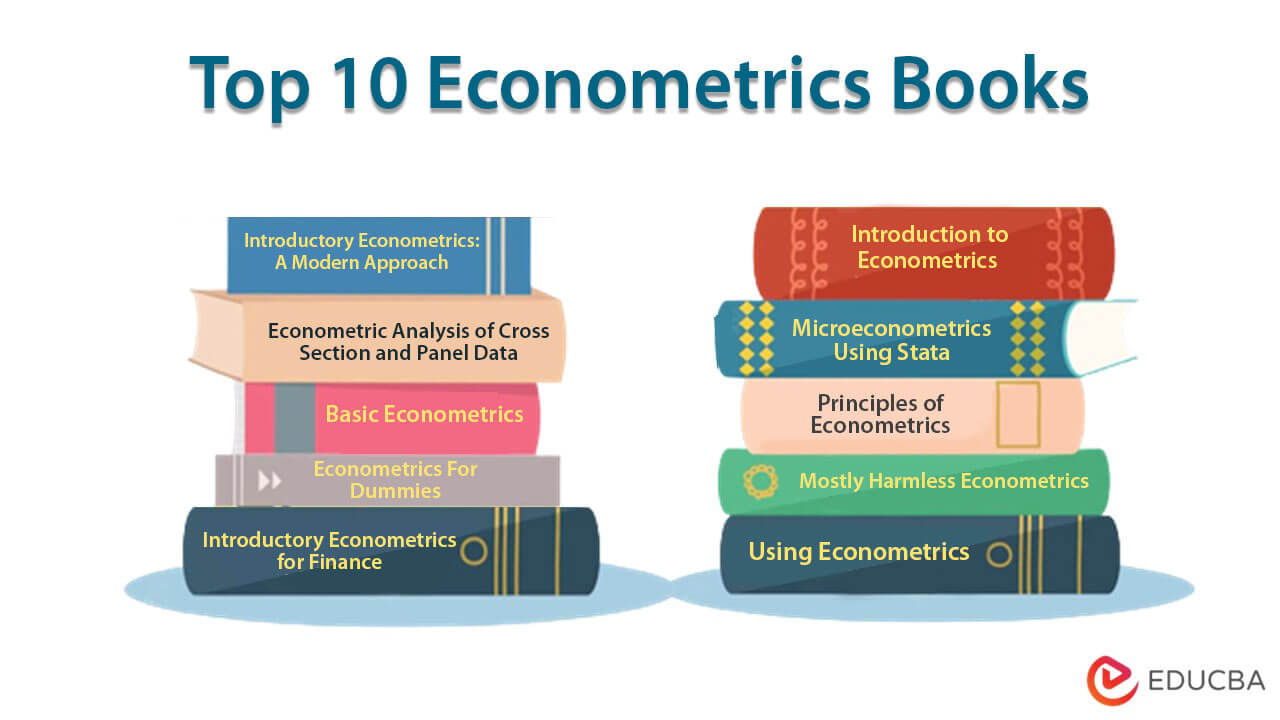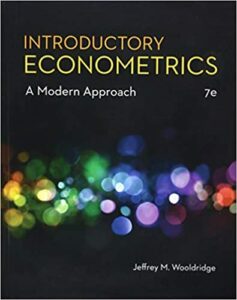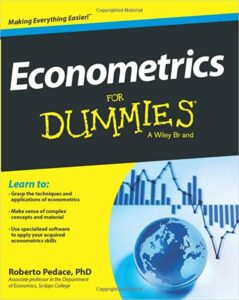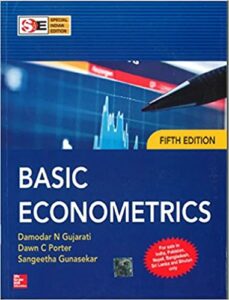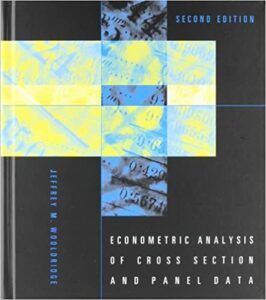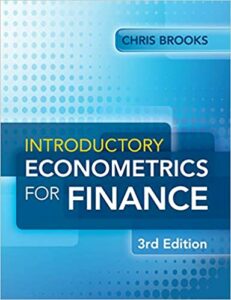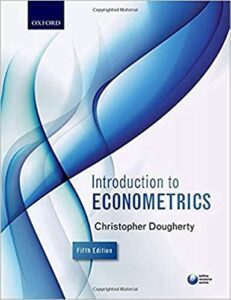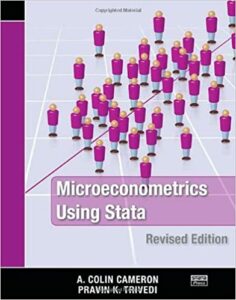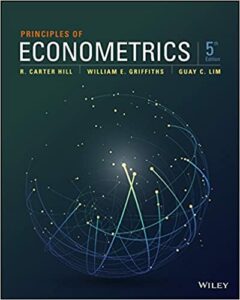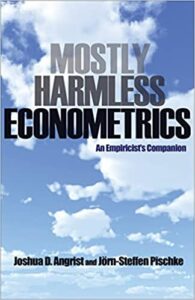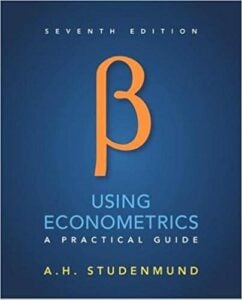Best Books for Understanding Econometrics
Economics is a subject that involves mathematics and statistics subjects too. Finding good econometrics books is very useful for someone who wants to pursue a career in economics.
This list of books is a guide for students, beginners, and professionals. These books will help everyone learn valuable econometrics topics regardless of their knowledge.
Here are the top 10 econometric books that will be handy in mastering your economics skills.
| # | Econometrics Books | Author | Published |
Rating |
| 1 | Introductory Econometrics: A Modern Approach | Jeffery M. Wooldridge | 2019 | Amazon: 4.5
Goodreads: 4.08 |
| 2 | Econometrics For Dummies | Roberto Pedace | 2013 | Amazon: 4.4
Goodreads: 3.82 |
| 3 | Basic Econometrics | Damodar Gujarati, Sangeetha Gunasekar, and Dawn Porter | 2017 | Amazon: 4.5
Goodreads: 3.78 |
| 4 | Econometric Analysis of Cross Section and Panel Data | Jeffrey M Wooldridge | 2010 | Amazon: 4.3
Goodreads: 4.29 |
| 5 | Introductory Econometrics for Finance | Chris Brooks | 2014 | Amazon: 4.5
Goodreads: 3.95 |
| 6 | Introduction to Econometrics | Christopher Dougherty | 2016 | Amazon: 4.5
Goodreads: 3.75 |
| 7 | Microeconometrics Using Stata | A. Colin Cameron and Pravin K. Trivedi | 2010 | Amazon: 4.7
Goodreads: 4.39 |
| 8 | Principles of Econometrics | R. Carter Hill, William E. Griffiths, and Guay C. Lim | 2018 | Amazon: 4.4
Goodreads: 3.79 |
| 9 | Mostly Harmless Econometrics | Joshua D. Angrist and Jörn-Steffen Pischke | 2009 | Amazon: 4.7
Goodreads: 4.13 |
| 10 | Using Econometrics | A. H. Studenmund | 2016 | Amazon: 4.5
Goodreads: 3.65 |
Let us now browse through each book’s review and core point.
Book #1: Introductory Econometrics: A Modern Approach
Author: Jeffery M. Wooldridge
Buy the book here.
Review:
The book involves the specialized mathematical description of economics to an applied interpretation based on empirical research methodology. The book covers the differences between modern applications of econometrics. It also explains the mechanics of econometrics using the methodology of a systematic approach. It is motivated by the significant problems applied researchers face.
Key Points:
- In addition to econometrics books, it also carries some interactive material and animated videos to master the subject using MindTap Technology.
- The book involves more practical rather than traditional or theoretical text as assumptions, introduced for better understanding.
- The examples used provide a reality of economic relationships and accessible frameworks.
Book #2: Econometrics For Dummies
Author: Roberto Pedace
Buy the book here.
Review:
The book is written in very plain and simple English making it easy to understand, although the text and the approach are very traditional. The text is short, crisp, and very useful for beginners or students who have just started their educational journey. The author did not limit the explanations using mathematics or statistics, but other methodologies like derivatives, classical violations, ordinary least squares, etc., are also employed.
Key Points:
- The author used many figures and examples, from the state model to statistical analysis.
- It makes it easier for a non-specialist to understand basic economics concepts.
- The book involves characteristics of the classical linear regression model, pain points while solving regression analysis, and common mistakes to avoid in applied econometrics.
Book #3: Basic Econometrics
Author: Damodar Gujarati, Sangeetha Gunasekar, and Dawn Porter
Buy the book here.
Review:
Considered one of the best elementary-level books, it explains economics using introductory algebra, calculus, and statistics. The language used in the book is lucid for undergraduate students as well. The book includes every “what,” “how,” and “why” of econometrics.
Key Points:
- The book involves new datasets, methodologies, and whole new research. Therefore, the information is up to date.
- The book explains econometrics without using complex statistics, algebra, or calculus.
- It involves every aspect of econometrics. The book is longer to read than other books, with 950 pages.
Book #4: Econometric Analysis of Cross-Section and Panel Data
Author: Jeffrey M Wooldridge
Buy the book here.
Review:
This book by Wooldridge is more advanced than the other book we discussed earlier. It is considered helpful for master’s or Doctorate level students. The book aims to tell readers what procedures work and why certain ones do not. The book is based on Cross Section and Panel Data methodology.
Key Points:
- Woodridge uses microeconomics while emphasizing intuitive thinking. The framework covers both linear and non-linear methods in detail.
- Tobit models, data count models, censored and missing data schemes and duration analysis are covered.
- The new edition covers a detailed explanation of “generalized instrumental variables” (GIV) estimation.
Book #5: Introductory Econometrics for Finance
Author: Chris Brooks
Buy the book here.
Review:
A comprehensive textbook written primarily for finance students presented in a well-illustrated manner. The book contains detailed case studies that help students to understand various economic and financial techniques.
Key Points:
- Although the previous edition has excellent examples and case studies, the new edition contains some new mathematical and statistical models.
- These models provide support for main industry-standard software packages.
- The self-assessment, key concepts, learning outcomes, and review questions allow students to grasp the topic or subject well.
Book #6: Introduction to Econometrics
Author: Christopher Dougherty
Buy the book here.
Review:
A perfect student-friendly book for individuals learning the basics of econometrics. The book contains statistical concepts like tables, data sets, charts, and hypothesis testing.
Key Points:
- The book contains a software manual and PowerPoint slides for the explanation, which can be customizable for teachers or lecturers.
- It has student-friendly text with an emphasis on regular practice and exercises.
- These are easy to grasp and apply various econometric techniques.
Book #7: Microeconometrics Using Stata
Author: A. Colin Cameron and Pravin K. Trivedi
Buy the book here.
Review:
The book covers micro econometrics research and its execution using Stata software. The author employed a new margins command, emphasizing both marginal effects at the means and average marginal effects.
Key Points:
- The author has employed simulation methods and detailed illustrations to illustrate various features of the estimators.
- He has also shown tests described and provided an in-depth Stata.
- The revised edition uses the mfx command instead of the xi command to specify indicator variables and interaction effects.
Book #8: Principles of Econometrics
Author: R. Carter Hill, William E. Griffiths, and Guay C. Lim
Buy the book here.
Review:
This book is an introductory undergraduate book. It covers finance and economics topics. It also covers accounting, agricultural economics, marketing, law, sociology, public policy, and political science. The approach of the book is practical-oriented.
Key Points:
- The book contains estimation, modeling, forecasting, and inference techniques.
- These are employed to gain a working knowledge of real-world economic problems.
- The book is very useful if topics besides finance and economics must be studied.
Book #9: Mostly Harmless Econometrics
Author: Joshua D. Angrist and Jörn-Steffen Pischke
Buy the book here.
Review:
This extremely popular book focuses on applying econometrics methods and techniques in real life. This book is not for beginners. The author employs econometric toolkits such as instrumental variables methods for analyzing natural experiments and linear regression for statistical control.
Key Points:
- The author covers quantile regression and new extensions regression discontinuity designs.
- The book also uses the differences-in-differences methods. This method exploits the policy changes.
- The book carries a non-traditional approach, and the author explains why fancier econometric methodology techniques are dangerous, futile, and unnecessary.
Book #10: Using Econometrics: A Practical Guide
Author: A. H. Studenmund
Buy the book here.
Review:
Though it has introductory text, the book is suitable for all levels of expertise. It covers both macro and micro-economic theories with mathematical and statistical learning.
Key Points:
- The book explains formulas and their application well with exercises and practice questions.
- The author used tables, pictographs, charts, etc., to explain the keywords and definitions in the book.
- The author describes the single equation linear regression with practical examples from real-life situations.
Recommended Books
Our top 10 econometrics books article aims to be of help to you. For more such books, EDUCBA recommends the following,
